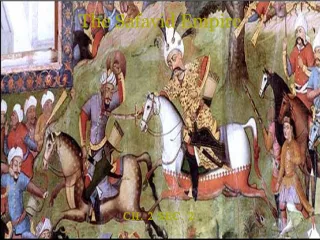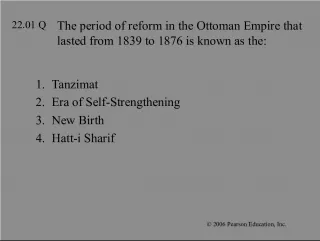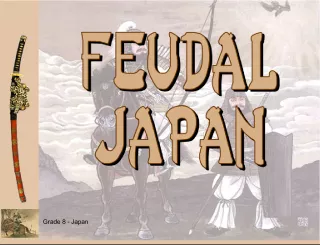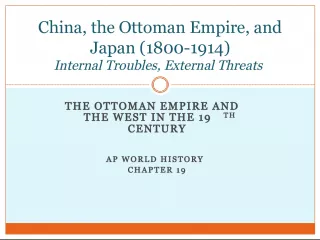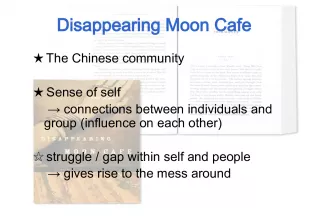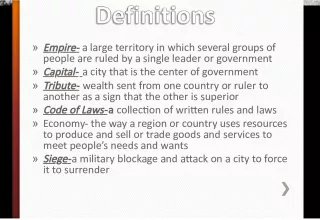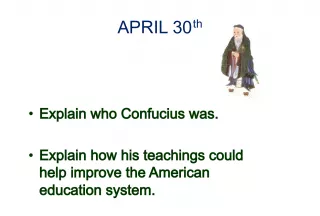The Contributions of the Xianbei States to the Reunification of the Chinese Empire


This article explores the role of the Xianbei States in the fourth century in the reunification of the Chinese Empire. It discusses the various Xianbei kingdoms and their contributions to the overall reunification effort.
- Uploaded on | 0 Views
-
 sasha
sasha
About The Contributions of the Xianbei States to the Reunification of the Chinese Empire
PowerPoint presentation about 'The Contributions of the Xianbei States to the Reunification of the Chinese Empire'. This presentation describes the topic on This article explores the role of the Xianbei States in the fourth century in the reunification of the Chinese Empire. It discusses the various Xianbei kingdoms and their contributions to the overall reunification effort.. The key topics included in this slideshow are Xianbei States, Reunification, Chinese Empire, Fourth Century, Kingdoms,. Download this presentation absolutely free.
Presentation Transcript
1. 2015/4/23 1 The Xianbei and its Kingdoms The Xianbei and its Kingdoms Reading: Reading: Klein, Kenneth Douglas, The contributions of the fourth century Xianbei States to the Reunification of the Chinese Empire . Klein, Kenneth Douglas, The contributions of the fourth century Xianbei States to the Reunification of the Chinese Empire .
2. 2015/4/23 2 The Xianbei and its Kingdoms The Xianbei and its Kingdoms The Xianbei The Xianbei The Murong The Murong The Former Yan The Former Yan The Later Yan The Later Yan The Southern Yan The Southern Yan The Western Qin The Western Qin The Southern Liang The Southern Liang Sixteen Kingdoms: A Comparison Sixteen Kingdoms: A Comparison Reference: Reference: Western Yan Western Yan Xianbei Women Xianbei Women
3. 2015/4/23 3 The Xianbei The Xianbei The Xianbei originated in Manchuria which was geographically isolated and not caught up in the constant warfare between rival warlord states. The Xianbei originated in Manchuria which was geographically isolated and not caught up in the constant warfare between rival warlord states. They were able to develop in a region that was outside the main area of conflict where it was possible to combine Chinese and tribal peoples. They were able to develop in a region that was outside the main area of conflict where it was possible to combine Chinese and tribal peoples. Under the Xiongnu, the Xianbei leadership was confined to the local chieftain level. Under the Xiongnu, the Xianbei leadership was confined to the local chieftain level. The Xianbei had a weak confederacy. The Xianbei had a weak confederacy. Authority was in the hands of small chiefs who only occasionally united under a charismatic leader. Authority was in the hands of small chiefs who only occasionally united under a charismatic leader.
4. 2015/4/23 4 The Xianbei (2) The Xianbei (2) They appeared in Chinese records for the first time about 45CE (Han Dynasty) relations with the Later Han were established in 49CE. They appeared in Chinese records for the first time about 45CE (Han Dynasty) relations with the Later Han were established in 49CE. Five years later, two chieftains presented themselves at court and received gifts from the Han emperor establishing tributary relations. Five years later, two chieftains presented themselves at court and received gifts from the Han emperor establishing tributary relations. At that time, the Xianbei had a language, and an egalitarian political system but with no hereditary succession or hierarchical clan structure. At that time, the Xianbei had a language, and an egalitarian political system but with no hereditary succession or hierarchical clan structure. The Xianbei was given Northern Mongolia after it allied with the forces of the Han dynasty and the Southern Xiongnu defeating the Northern Xiongnu. The Xianbei was given Northern Mongolia after it allied with the forces of the Han dynasty and the Southern Xiongnu defeating the Northern Xiongnu. During the Three Kingdoms Period, the Murong was just one of many nomadic tribes in the northeast; in 237, Wei Xuandi used the Murong against the warlords in Liaodong. During the Three Kingdoms Period, the Murong was just one of many nomadic tribes in the northeast; in 237, Wei Xuandi used the Murong against the warlords in Liaodong. The Murong received titles from the Wei (220-265) court The Murong received titles from the Wei (220-265) court
5. 2015/4/23 5 The Xianbei (3) The Xianbei (3) During the Sixteen Kingdoms Period, the clans that formed five of the 16 Kingdoms were the Murong (all of the Yan kingdoms), the Qifu, and the Tufa (formerly named Tuoba): During the Sixteen Kingdoms Period, the clans that formed five of the 16 Kingdoms were the Murong (all of the Yan kingdoms), the Qifu, and the Tufa (formerly named Tuoba): They had established the following kingdoms*: They had established the following kingdoms*: The Former Yan ; 337-370 Murong (33 years) The Former Yan ; 337-370 Murong (33 years) The Later Yan ; 383-407 Murong (24 years) The Later Yan ; 383-407 Murong (24 years) The Southern Yan ; 398-410 Murong (12 years) The Southern Yan ; 398-410 Murong (12 years) Western Qin (385-400; 409-431) -- Qifu (15+22=37 years) Western Qin (385-400; 409-431) -- Qifu (15+22=37 years) Southern Liang (397-414) -- Tufa (17 years) Southern Liang (397-414) -- Tufa (17 years) In 440, the Xianbei united all of China under the Northern Wei (386-534) under the Tuoba ( ) clan. In 440, the Xianbei united all of China under the Northern Wei (386-534) under the Tuoba ( ) clan. *Another Murong kingdom, the Western Yan (384-394), was not recognized by historians as one of the Sixteen Kingdoms as it lasted for only 10 years and had only one ruler with no successor. *Another Murong kingdom, the Western Yan (384-394), was not recognized by historians as one of the Sixteen Kingdoms as it lasted for only 10 years and had only one ruler with no successor.
6. 2015/4/23 6 The Xianbei (4) The Xianbei (4) State State Founder Founder Year Year Ethnicity Ethnicity Location Location Conquered by Conquered by Set up at the end of W. Jin Set up at the end of W. Jin Set up at the beginning of E. Jin Set up at the beginning of E. Jin Former Yan Former Yan Murong Zhn Murong Zhn 337-370 337-370 Xianbei Xianbei Liaodong Liaodong F. Qin F. Qin Set up after the Battle of The River Fei Set up after the Battle of The River Fei Later Yan Later Yan Southern Liang Southern Liang Southern Yan Southern Yan Western Qin Western Qin Murong Chiu Murong Chiu Tufa Wugu Tufa Wugu Murong De Murong De Qifun Guoren Qifun Guoren 383-407 383-407 397-414 397-414 398-410 398-410 385-400; 409-431 Xianbei Xianbei Xianbei Xianbei Xianbei Xianbei Xianbei Xianbei N. Hebei N. Hebei Central Gansu Central Gansu Shandong Shandong Central Gansu Central Gansu N. Yan N. Yan E. Jin E. Jin E. Jin E. Jin Xia Xia Not part of the 16 Kingdoms Not part of the 16 Kingdoms Western Yan Western Yan Murong Hung Murong Hung 384-394 384-394 Xianbei Xianbei E. of Fen River E. of Fen River Not one of the 16 Not one of the 16
7. The Yan Kingdoms Former Yan (Liaodong), Later Yan (N. Hebei), Southern Yan (Shandong)
8. 2015/4/23 8 The Murong The Murong The Murong had not been able to assert control over the steppe from their isolated position in Liaodong. The Murong had not been able to assert control over the steppe from their isolated position in Liaodong. When the Xiongnu collapsed, border states ruled by the Murong clan of Xianbei origin survived by stressing defense and internal organization. When the Xiongnu collapsed, border states ruled by the Murong clan of Xianbei origin survived by stressing defense and internal organization. They were allies of China as well as Chinas raiders. They were allies of China as well as Chinas raiders. The leader of the Xianbei in the mid 200s was Murong Hui , (269-333) who had initially fought against the Jin forces. The leader of the Xianbei in the mid 200s was Murong Hui , (269-333) who had initially fought against the Jin forces. He submitted to Jin in 289 and was given the title Duke of Liaodong. He submitted to Jin in 289 and was given the title Duke of Liaodong. He was the first Murong leader to provide his sons with a Chinese education and adopt some Chinese customs. He was the first Murong leader to provide his sons with a Chinese education and adopt some Chinese customs. Consequently, for three generations the Murong leaders received Chinese education. Consequently, for three generations the Murong leaders received Chinese education.
9. 2015/4/23 9 The Murong (2) The Murong (2) After constant attacks with fellow Xianbei chief, Duan Jie , Murong Hui married one of Duan Jies daughters. After constant attacks with fellow Xianbei chief, Duan Jie , Murong Hui married one of Duan Jies daughters. From then on, the Murongs intermarried with the Duan and shared power with them (but reserved the dominant position for themselves). From then on, the Murongs intermarried with the Duan and shared power with them (but reserved the dominant position for themselves). Murong Hui and his Duan consort had three sons -- Murong Huang (297-348), Murong Ren , and Murong Zhao . Murong Hui and his Duan consort had three sons -- Murong Huang (297-348), Murong Ren , and Murong Zhao . Murong Hui changed the Murong from a tribal to a mixed state society; he developed a new centralized bureaucracy that would not alienate the tribal followers. Murong Hui changed the Murong from a tribal to a mixed state society; he developed a new centralized bureaucracy that would not alienate the tribal followers.
10. 2015/4/23 10 The Murong (4) The Murong (4) The three major changes were: The three major changes were: Adopting and encouraging agriculture and craft production; it was so successful that he was able to export grain to China. Adopting and encouraging agriculture and craft production; it was so successful that he was able to export grain to China. Using Chinese administrators for organizing this new economy. Using Chinese administrators for organizing this new economy. Using Chinese advisors to organize the army which remained in Xianbei hands -- its units still retained a tribal organization but the ability for local tribal leaders to act on their own was reduced. Using Chinese advisors to organize the army which remained in Xianbei hands -- its units still retained a tribal organization but the ability for local tribal leaders to act on their own was reduced. In battle and in planning they were taking orders from a central command. In battle and in planning they were taking orders from a central command. In 302, the Murong was attacked twice but was able to defeat them despite the attackers numerical superiority. In 302, the Murong was attacked twice but was able to defeat them despite the attackers numerical superiority. Impressed by the successes, many Xianbei joined the Murong. Impressed by the successes, many Xianbei joined the Murong.
11. 2015/4/23 11 The Murong (5) The Murong (5) Murong Huis half century of rule provided the stability and continuity resulting in Xianbei descendants to establish the Northern Zhou dynasty (557-581). Murong Huis half century of rule provided the stability and continuity resulting in Xianbei descendants to establish the Northern Zhou dynasty (557-581). During Murong Hui's rule as tribal chief, the Jin Dynasty's central government was in constant turmoil and eventually collapsed due to infighting and rebellions. During Murong Hui's rule as tribal chief, the Jin Dynasty's central government was in constant turmoil and eventually collapsed due to infighting and rebellions. The Murong refused to be drawn into the fight, so, except for some local battles with the neighbors, Murong Hui had many years of peace to develop his kingdom. The Murong refused to be drawn into the fight, so, except for some local battles with the neighbors, Murong Hui had many years of peace to develop his kingdom. As the Xianbei kingdom was at peace and was able to offer food and safety, many refugees came from the south. As the Xianbei kingdom was at peace and was able to offer food and safety, many refugees came from the south. Murong Hui treated the ethnic Han refugees with kindness so most chose to stay, greatly strengthening his power. Murong Hui treated the ethnic Han refugees with kindness so most chose to stay, greatly strengthening his power.
12. 2015/4/23 12 The Murong (6) The Murong (6) The majority of the refugees were farmers but there were also artisans and former officials and Murong Hui tried to attract these refugees in order to increase the productivity. The majority of the refugees were farmers but there were also artisans and former officials and Murong Hui tried to attract these refugees in order to increase the productivity. The Chinese officials became an important part of the Murong court advising Murong Hui on strategy and government and helping to lay the foundation for a dynasty The Chinese officials became an important part of the Murong court advising Murong Hui on strategy and government and helping to lay the foundation for a dynasty The Chinese advisors convinced him of the possibility of ruling China itself. The Chinese advisors convinced him of the possibility of ruling China itself. Around 322, Murong Hui began attacking the neighboring Xianbei states and each conquered tribe was incorporated into the Murong state as a separate unit, increasing the size of the army; border Chinese were also conquered and put to work. Around 322, Murong Hui began attacking the neighboring Xianbei states and each conquered tribe was incorporated into the Murong state as a separate unit, increasing the size of the army; border Chinese were also conquered and put to work. By the time of his death, he was head of an emerging dynasty and the population had increased 10 times from the start of his reign. By the time of his death, he was head of an emerging dynasty and the population had increased 10 times from the start of his reign.
13. 2015/4/23 13 The Murong (7) The Murong (7) Murong Hui never claimed any title beyond that given to him by the Jin. Murong Hui never claimed any title beyond that given to him by the Jin. His son, Murong Huang (297-348), transformed the Murong from a nomadic tribe to a Chinese state. His son, Murong Huang (297-348), transformed the Murong from a nomadic tribe to a Chinese state. It was not easy as the Murong had a long tradition of fraternal/lateral succession, a tradition that was in conflict with the Chinese tradition of primogeniture. It was not easy as the Murong had a long tradition of fraternal/lateral succession, a tradition that was in conflict with the Chinese tradition of primogeniture. A compromise was made in which the ruler succeeded in Chinese fashion but his brothers and uncles were appointed to key posts. A compromise was made in which the ruler succeeded in Chinese fashion but his brothers and uncles were appointed to key posts. The best generals and advisors were members of the imperial lineage who looked at the state as their common property. The best generals and advisors were members of the imperial lineage who looked at the state as their common property. The chances of civil wars of succession were lessened but not eliminated and Huang drove his brothers into exile or rebellion. The chances of civil wars of succession were lessened but not eliminated and Huang drove his brothers into exile or rebellion. Murong Huang proclaimed himself King of Yan in 337 which the Jin emperor was forced to accept in 341; of his 18 sons, three became emperors. Murong Huang proclaimed himself King of Yan in 337 which the Jin emperor was forced to accept in 341; of his 18 sons, three became emperors.
14. 2015/4/23 14 The Former Yan The Former Yan Yan was the name of the old northeastern kingdom in the Warring States Period. Yan was the name of the old northeastern kingdom in the Warring States Period. By claiming the title of King of Yan, Murong Huang downplayed his tribal origins. By claiming the title of King of Yan, Murong Huang downplayed his tribal origins. Most of Manchuria and the Jin court formally recognized Murong Huangs claim as king and his son, Murong Jun , had the title "Prince of Yan". Most of Manchuria and the Jin court formally recognized Murong Huangs claim as king and his son, Murong Jun , had the title "Prince of Yan". His many Chinese advisors never commented on tribal affairs nor asked the Xianbei to take up farming and guided him toward pragmatic policies that would increase the states power. His many Chinese advisors never commented on tribal affairs nor asked the Xianbei to take up farming and guided him toward pragmatic policies that would increase the states power. Instead, they pressed for a six point program: Instead, they pressed for a six point program:
15. 2015/4/23 15 The Former Yan (2) The Former Yan (2) Waterworks for irrigation should be repaired and maintained. Waterworks for irrigation should be repaired and maintained. More refugees put to work farming. More refugees put to work farming. Excess merchants and craftsman forced to farm. Excess merchants and craftsman forced to farm. The number of students cut and the excess forced to farm. The number of students cut and the excess forced to farm. The ruler should listen to criticism. The ruler should listen to criticism. Excess officials dismissed. Excess officials dismissed. Murong Huang agreed to five of the suggestions except for the dismissal of excess officials as he was expanding the state and the nomads had a tradition of buying their allies with titles and offices. Murong Huang agreed to five of the suggestions except for the dismissal of excess officials as he was expanding the state and the nomads had a tradition of buying their allies with titles and offices.
16. 2015/4/23 16 The Former Yan (3) The Former Yan (3) After the death of Murong Huang, Murong Jun (319- 360), his eldest son and successor, spent the next few years crushing small rebellions and conquering eastern China. After the death of Murong Huang, Murong Jun (319- 360), his eldest son and successor, spent the next few years crushing small rebellions and conquering eastern China. In 352, Yan forces captured the Zhao emperor Ran Min and seized most of the former Later Zhao territory. In 352, Yan forces captured the Zhao emperor Ran Min and seized most of the former Later Zhao territory. Murong Jun declared himself emperor in 352 and incorporated their Chinese territories into a functioning government. Murong Jun declared himself emperor in 352 and incorporated their Chinese territories into a functioning government. To distinguish the state established by Murong Jun from other Yan states historians refer to it as the Former Yan (337- 370). To distinguish the state established by Murong Jun from other Yan states historians refer to it as the Former Yan (337- 370).
17. 2015/4/23 17 The Former Yan (4) The Former Yan (4) During Murong Juns reign the state expanded from modern Liaoning and parts of Hebei to nearly all of the territory north of the Yellow River as well as some substantial holdings south of the Yellow River. During Murong Juns reign the state expanded from modern Liaoning and parts of Hebei to nearly all of the territory north of the Yellow River as well as some substantial holdings south of the Yellow River. Xianbei strategies towards the steppe people were more sophisticated than those of the Chinese. Xianbei strategies towards the steppe people were more sophisticated than those of the Chinese. Tribal leaders were won over by a series of marriage alliances linking them to the Murong. Tribal leaders were won over by a series of marriage alliances linking them to the Murong. They disrupted formations of tribal confederations. They disrupted formations of tribal confederations. When an attack was launched it involved fast moving troops who knew steppe conditions and its aim was the capture of whole peoples. When an attack was launched it involved fast moving troops who knew steppe conditions and its aim was the capture of whole peoples.
18. 2015/4/23 18 The Former Yan (4) The Former Yan (4) The Murong success was due to their ability to: The Murong success was due to their ability to: Control the steppes. Control the steppes. Maintain Xianbei loyalty. Maintain Xianbei loyalty. Willingness to employ Chinese officials: Willingness to employ Chinese officials: Who promoted agricultural production Who promoted agricultural production Who gave the Xianbei ruling skills and a financial base. Who gave the Xianbei ruling skills and a financial base. Who maintained the support of the subject Chinese population. Who maintained the support of the subject Chinese population. When Murong Jun died in 360, the throne went to his young son, but the court questioned his fitness to rule. When Murong Jun died in 360, the throne went to his young son, but the court questioned his fitness to rule. They tried to persuade Juns brother, Murong Ke (d.357), to take the throne (fraternal/lateral succession) but Murong Ke refused; instead, he ruled as the regent. They tried to persuade Juns brother, Murong Ke (d.357), to take the throne (fraternal/lateral succession) but Murong Ke refused; instead, he ruled as the regent.
19. 2015/4/23 19 The Former Yan (5) The Former Yan (5) During Murong Kes regency, Yan reached new heights of power as Ke led it to new conquests. During Murong Kes regency, Yan reached new heights of power as Ke led it to new conquests. On his deathbed, Ke recommended that his brother, Murong Ba , later renamed Murong Chui , to succeed him as regent. On his deathbed, Ke recommended that his brother, Murong Ba , later renamed Murong Chui , to succeed him as regent. But a rival candidate, Murong Ping seized power and the state declined quickly under his command: But a rival candidate, Murong Ping seized power and the state declined quickly under his command: Internally, the political elite began to expand their domains and deprive the treasury of revenue. Internally, the political elite began to expand their domains and deprive the treasury of revenue. Externally, it was facing strong military rivals the Former Qin in the west and the Eastern Jin to the south. Externally, it was facing strong military rivals the Former Qin in the west and the Eastern Jin to the south. Murong Chui was forced to flee to the Former Qin, Yans enemy in the west, and helped them conquer the Former Yan (see Slides 34, 35) Murong Chui was forced to flee to the Former Qin, Yans enemy in the west, and helped them conquer the Former Yan (see Slides 34, 35)
20. 2015/4/23 20 The Later Yan The Later Yan The Later Yan (384-407/9), was founded by Murong Chui (r.384-396) who had fled from the Former Yan and worked with the Former Qin. The Later Yan (384-407/9), was founded by Murong Chui (r.384-396) who had fled from the Former Yan and worked with the Former Qin. In 384, Chui rebelled against the Former Qin and declared a new dynasty, the Later Yan. In 384, Chui rebelled against the Former Qin and declared a new dynasty, the Later Yan. This caused the other Murong leaders his sons, nephews and the younger brother of the last emperor of the Former Yan to rebel against the Former Qin. This caused the other Murong leaders his sons, nephews and the younger brother of the last emperor of the Former Yan to rebel against the Former Qin. In 387, Murong Chui proclaimed himself emperor and allied with Tuoba Gui against the Eastern Jin. In 387, Murong Chui proclaimed himself emperor and allied with Tuoba Gui against the Eastern Jin. When both Murong Chui and Tuoba Gui grew in strength, their interests began to clash and Tuoba Gui began to ally with the Western Yan (not one of the Sixteen Kingdoms). When both Murong Chui and Tuoba Gui grew in strength, their interests began to clash and Tuoba Gui began to ally with the Western Yan (not one of the Sixteen Kingdoms). In 393 Murong Chui attacked and eliminated the Western Yan then attacked Tuoba Gui in (395) but he died (396) and his successor, Murong Bao (r.396-398), was killed in a power struggle. In 393 Murong Chui attacked and eliminated the Western Yan then attacked Tuoba Gui in (395) but he died (396) and his successor, Murong Bao (r.396-398), was killed in a power struggle.
21. 2015/4/23 21 The Later Yan (2) The Later Yan (2) He was succeeded by his (Murong Baos) son, Murong Sheng (398-401) who was killed in a rebellion. He was succeeded by his (Murong Baos) son, Murong Sheng (398-401) who was killed in a rebellion. The Empress Dowager, mother of Murong Sheng, then forced the court to bypass both the former emperors son and brother and instead enthrone Murong Shengs uncle, Murong Xi (402-407), son of Murong Chui. The Empress Dowager, mother of Murong Sheng, then forced the court to bypass both the former emperors son and brother and instead enthrone Murong Shengs uncle, Murong Xi (402-407), son of Murong Chui. The Empress Dowager was having an affair with Murong Xi who was 12 years younger than her son, Murong Sheng. The Empress Dowager was having an affair with Murong Xi who was 12 years younger than her son, Murong Sheng. Murong Xi was said to have been cruel and so was killed in another coup and the adopted son of Murong Bao (Gao Yn) succeeded (407) to the throne as the last emperor of the Later Yan. Murong Xi was said to have been cruel and so was killed in another coup and the adopted son of Murong Bao (Gao Yn) succeeded (407) to the throne as the last emperor of the Later Yan.
22. 2015/4/23 22 The Northern Yan The Northern Yan The adopted son, Murong Yn or Gao Yn was ethnically Korean and a descendant of one of the three royal houses whose ancestors were captured by Former Yan. The adopted son, Murong Yn or Gao Yn was ethnically Korean and a descendant of one of the three royal houses whose ancestors were captured by Former Yan. He was adopted into the Later Yan imperial house after helping the emperor Murong Bao put down a rebellion by Murong Bao's son. He was adopted into the Later Yan imperial house after helping the emperor Murong Bao put down a rebellion by Murong Bao's son. He declared a new dynasty in 409 which historians refer to as the Northern Yan. He declared a new dynasty in 409 which historians refer to as the Northern Yan. He was assassinated and his successor, one of the generals, Feng Ba , (r.409-430) was of Han ancestry. He was assassinated and his successor, one of the generals, Feng Ba , (r.409-430) was of Han ancestry. After his death, his brother and successor Feng Hong (430- 438) killed all of Feng Bas 10 sons. After his death, his brother and successor Feng Hong (430- 438) killed all of Feng Bas 10 sons.
23. 2015/4/23 23 Southern Yan Southern Yan The Southern Yan (398-410) was established by Murong De (336-405), 15 th son, of Murong Huang. The Southern Yan (398-410) was established by Murong De (336-405), 15 th son, of Murong Huang. He was also the younger brother of emperor Murong Jun of the Former Yan and Murong Chui founder of the Later Yan He was also the younger brother of emperor Murong Jun of the Former Yan and Murong Chui founder of the Later Yan After Murong Chui's son Murong Bao lost most of Later Yan's territory to Northern Wei, Murong De went south with his troops and established Southern Yan, in modern Shandong but was unable to expand further. After Murong Chui's son Murong Bao lost most of Later Yan's territory to Northern Wei, Murong De went south with his troops and established Southern Yan, in modern Shandong but was unable to expand further. Southern Yan was conquered by the Eastern Jin in 410 (some histories say it was conquered by the Liu-Song successor dynasty to the Eastern Jin -- as the leading general, Liu Yu , later usurped the Jin throne and founded Liu-Song. Southern Yan was conquered by the Eastern Jin in 410 (some histories say it was conquered by the Liu-Song successor dynasty to the Eastern Jin -- as the leading general, Liu Yu , later usurped the Jin throne and founded Liu-Song. Although Murong De tried to establish a working administration he was unable to do so as his reign was short only seven years (his successor ruled for five years). Although Murong De tried to establish a working administration he was unable to do so as his reign was short only seven years (his successor ruled for five years). The Southern Yan continued to exist until 410 by allying itself with the Later Qin. The Southern Yan continued to exist until 410 by allying itself with the Later Qin.
24. 2015/4/23 24 Western Qin Western Qin The ruling family of Western Qin was the Qifu clan. The ruling family of Western Qin was the Qifu clan. It was Xianbei but it was made up of a confederation of several groups who came into the frontier lands of Inner Mongolia from the steppes. It was Xianbei but it was made up of a confederation of several groups who came into the frontier lands of Inner Mongolia from the steppes. These groups formed an army that shared a common mythology. These groups formed an army that shared a common mythology. They banded together to push into the rich frontier lands occupied by farmers, largely Chinese and moved into modern Gansu in the mid 3 rd Century. They banded together to push into the rich frontier lands occupied by farmers, largely Chinese and moved into modern Gansu in the mid 3 rd Century. The ancestors of the founder, Qi-fu Guoren (r.385- 388) had come from the desert regions and his father, had submitted to the Former Qin. The ancestors of the founder, Qi-fu Guoren (r.385- 388) had come from the desert regions and his father, had submitted to the Former Qin. When Fu Jin was killed, Qi-fu Guoren and his uncle rebelled and in 385 Qifu Guoren founded the most minor of all the Sixteen Kingdoms, the Western Qin (385-400, 409-431). When Fu Jin was killed, Qi-fu Guoren and his uncle rebelled and in 385 Qifu Guoren founded the most minor of all the Sixteen Kingdoms, the Western Qin (385-400, 409-431). Western Qin was destroyed by Yao Xing of the Later Qin in 400 but the Qifu was able to come back and in 409. Western Qin was destroyed by Yao Xing of the Later Qin in 400 but the Qifu was able to come back and in 409.
25. 2015/4/23 25 Western Qin (2) Western Qin (2) The first part of their reign was (385-400) The first part of their reign was (385-400) After being defeated by Yao Xing of the Later Qin, they came back and ruled from 409-431 when they were finally conquered by the Xiongnu Kingdom, Da Xia . After being defeated by Yao Xing of the Later Qin, they came back and ruled from 409-431 when they were finally conquered by the Xiongnu Kingdom, Da Xia . There were four reigns: There were four reigns: the founder ruled for 3 years, the founder ruled for 3 years, the second for 2 years and was toppled but came back 9 years later and ruled for 13 years. the second for 2 years and was toppled but came back 9 years later and ruled for 13 years. the third king ruled for 17 years and the third king ruled for 17 years and the last for 3 years. the last for 3 years. All the rulers called themselves kings. All the rulers called themselves kings.
26. 2015/4/23 26 Southern Liang Southern Liang The Southern Liang (397-414) was founded by the Tufa family of Xianbei ethnicity. The Southern Liang (397-414) was founded by the Tufa family of Xianbei ethnicity. The name of the empire Liang comes from the prefecture Liangzhou . The name of the empire Liang comes from the prefecture Liangzhou . The Tufa clan was a distant relative of the Tuoba clan but according to the History of the Jin ( ) the name was changed from Tuoba to Tufa because one of the Tufa ancestors was born on a blanket, and in the Xianbei language, "Tufa" meant "blanket." The Tufa clan was a distant relative of the Tuoba clan but according to the History of the Jin ( ) the name was changed from Tuoba to Tufa because one of the Tufa ancestors was born on a blanket, and in the Xianbei language, "Tufa" meant "blanket."
27. 2015/4/23 27 Southern Liang Southern Liang When the ruler of Liang, L Guang, was in trouble, the Tufa broke off one end of the Liang state to form the Southern Liang. When the ruler of Liang, L Guang, was in trouble, the Tufa broke off one end of the Liang state to form the Southern Liang. All rulers of the Southern Liang proclaimed themselves king. All rulers of the Southern Liang proclaimed themselves king. There were three rulers, the first ruled for 2 years, the second for 3, and the third for 12. There were three rulers, the first ruled for 2 years, the second for 3, and the third for 12. There was continuous warfare with the surrounding states during the last years of the dynasty. There was continuous warfare with the surrounding states during the last years of the dynasty. In 414 the Tufa king surrendered to the Western Jin. In 414 the Tufa king surrendered to the Western Jin.
28. 2015/4/23 28 Sixteen Kingdoms: A Comparison Sixteen Kingdoms: A Comparison The first Xiongnu dynasty fell as the nomads thought the court was too Chinese. The first Xiongnu dynasty fell as the nomads thought the court was too Chinese. The second Zhao dynasty of Shi Le and Shi Hu fell because it was unable to provide a competent government for its Chinese subjects who revolted and killed the foreign advisors. The second Zhao dynasty of Shi Le and Shi Hu fell because it was unable to provide a competent government for its Chinese subjects who revolted and killed the foreign advisors. Like the Xiongnu kingdoms, the Ba and Di kingdoms were short-lived Cheng-Han (43 years); Former Qin (44 Years); Later Qin (33 years), Later Liang (17 years). Like the Xiongnu kingdoms, the Ba and Di kingdoms were short-lived Cheng-Han (43 years); Former Qin (44 Years); Later Qin (33 years), Later Liang (17 years). Succession to leadership in the Ba and Di kingdoms was usually violent both Li Shou and Fu Jin rose to power after murdering and deposing the former emperors. Succession to leadership in the Ba and Di kingdoms was usually violent both Li Shou and Fu Jin rose to power after murdering and deposing the former emperors. The greatest problem for the Former Qin was to create a central government which could control the tribal peoples and at the same time provide an administration acceptable to the Chinese. The greatest problem for the Former Qin was to create a central government which could control the tribal peoples and at the same time provide an administration acceptable to the Chinese.
29. Sixteen Kingdoms: A Comparison (2) Sixteen Kingdoms: A Comparison (2) The first Xianbei dynasties survived the initial anarchy period because they were well-organized and conservative. The first Xianbei dynasties survived the initial anarchy period because they were well-organized and conservative. The rulers had learned through experience and experimentation to organize and run a dual system of administration for the Xianbei and the Chinese population on a small scale where mistakes in policy were not fatal. The rulers had learned through experience and experimentation to organize and run a dual system of administration for the Xianbei and the Chinese population on a small scale where mistakes in policy were not fatal. They were able to develop stable forms of government over several generations. They were able to develop stable forms of government over several generations. These Xianbei dynasties had enough power to defend themselves against invasions. These Xianbei dynasties had enough power to defend themselves against invasions. The Murong rule lasted for over a 100 years before they declared the establishment of the Former Yan. The Murong rule lasted for over a 100 years before they declared the establishment of the Former Yan. 2015/4/23 29
30. 2015/4/23 30 Sixteen Kingdoms: A Comparison (3) Sixteen Kingdoms: A Comparison (3) The Xianbei Kingdoms of Yan, did not last that long either but they have had experience in the gradual development of a dual organization for government administration. The Xianbei Kingdoms of Yan, did not last that long either but they have had experience in the gradual development of a dual organization for government administration. The Murong rulers failed to conquer all north China because of: The Murong rulers failed to conquer all north China because of: Internal power struggles. Internal power struggles. Offices filled with relatives Offices filled with relatives The very able ones helped to extend Murong rule to the Central Plain (during the collapse of the Former Zhao) The very able ones helped to extend Murong rule to the Central Plain (during the collapse of the Former Zhao) Others were not so able and the Yan was later conquered by the Former Qin. Others were not so able and the Yan was later conquered by the Former Qin. They had to face the power of the Northern Wei, led by the Xianbei Tuoba clan. They had to face the power of the Northern Wei, led by the Xianbei Tuoba clan.
31. 2015/4/23 31 Sixteen Kingdoms: A Comparison (4) Sixteen Kingdoms: A Comparison (4) In developing a dual administration system, the Xianbei eventually evolved a working government until the Tuoba clan went on to conquer all of northern China and ruled it as the Northern Wei dynasty (420-589) for 169 years. In developing a dual administration system, the Xianbei eventually evolved a working government until the Tuoba clan went on to conquer all of northern China and ruled it as the Northern Wei dynasty (420-589) for 169 years. Different Xianbei clans and people of Xianbei and mixed origins went on to establish the Northern Qi, the Northern Zhou, the Sui and the Tang dynasties. Different Xianbei clans and people of Xianbei and mixed origins went on to establish the Northern Qi, the Northern Zhou, the Sui and the Tang dynasties. The Sui was able to unite all of China. The Sui was able to unite all of China. The Tang is regarded by historians as a high point in Chinese civilization. Its territory, acquired through the military campaigns of its early rulers, was greater than that of the Han period, and rivaled that of the later Mongol Yuan and the Manchu Qing dynasties. The Tang is regarded by historians as a high point in Chinese civilization. Its territory, acquired through the military campaigns of its early rulers, was greater than that of the Han period, and rivaled that of the later Mongol Yuan and the Manchu Qing dynasties.
32. 2015/4/23 32 Next Reading Next Reading Holmgren, Jennifer, Marriage, Kinship and Power in Northern China: Holmgren, Jennifer, Marriage, Kinship and Power in Northern China: Imperial marriage in the Native Chinese and non-Han State, Han to Ming Imperial marriage in the Native Chinese and non-Han State, Han to Ming The Harem in Northern Wei Politics, 398-493 AD: A Study of Tuoba attitudes towards the institution of empress dowager and regency governments in the Chinese dynastic system during early Northern Wei The Harem in Northern Wei Politics, 398-493 AD: A Study of Tuoba attitudes towards the institution of empress dowager and regency governments in the Chinese dynastic system during early Northern Wei Family, Marriage and Political Power in Sixth Century China: A study of the Gao Family of the Northern Ch i, c.520-550 , in VI, pp 1-50. Family, Marriage and Political Power in Sixth Century China: A study of the Gao Family of the Northern Ch i, c.520-550 , in VI, pp 1-50. Dien, Albert E., ed., State and society in early medieval China ,Politics of the Inner Court under the Hou-chu (Last Lord of the Northern Chi, c.. 565-73 in pp 269-330. Dien, Albert E., ed., State and society in early medieval China ,Politics of the Inner Court under the Hou-chu (Last Lord of the Northern Chi, c.. 565-73 in pp 269-330.
33. 2015/4/23 33 Reference Western Yan Reference Western Yan Historians do not include the Western Yan (384-394) among the Sixteen Kingdoms as it lasted for only 10 years. Historians do not include the Western Yan (384-394) among the Sixteen Kingdoms as it lasted for only 10 years. After the Former Qin ended, Murong Hong (d. 384) founded his empire of (Western) Yan Murong Hong was a son of the Former Yan emperor, Murong Jun and a younger brother of Former Yan emperor, Murong Wei. After the Former Qin ended, Murong Hong (d. 384) founded his empire of (Western) Yan Murong Hong was a son of the Former Yan emperor, Murong Jun and a younger brother of Former Yan emperor, Murong Wei. In 384, he heard that his uncle Murong Chui had rebelled against Former Qin and so he gathered several thousand Xianbei soldiers and claimed his former title of Prince. In 384, he heard that his uncle Murong Chui had rebelled against Former Qin and so he gathered several thousand Xianbei soldiers and claimed his former title of Prince. He was killed by his officials who supported his brother Murong Chong (d. 386) who wanted to lead them back to their homeland in the East. He was killed by his officials who supported his brother Murong Chong (d. 386) who wanted to lead them back to their homeland in the East. In their march eastward, the Western Yan was weakened by power struggles and was defeated by Murong Chui. In their march eastward, the Western Yan was weakened by power struggles and was defeated by Murong Chui.
34. 2015/4/23 34 Reference Xianbei Women Reference Xianbei Women Empress Duan, Wife of Murong Huang Empress Duan, Wife of Murong Huang Empress Kezuhun, Wife of Murong Jun* Empress Kezuhun, Wife of Murong Jun* Princess Duan, First Wife of Murong Chui* Princess Duan, First Wife of Murong Chui* Empress Duan Yuanfei, 5 th Wife of Murong Chui Empress Duan Yuanfei, 5 th Wife of Murong Chui
35. 2015/4/23 35 Xianbei Women: Empress Duan, Wife of Murong Huang Xianbei Women: Empress Duan, Wife of Murong Huang Lady Duan (Empress Duan Wenming (ca.337) was a daughter of a tribal chief, a Xianbei state of during the Three Kingdoms Period. Lady Duan (Empress Duan Wenming (ca.337) was a daughter of a tribal chief, a Xianbei state of during the Three Kingdoms Period. Curing the Jin dynasty the clan adopted the Han name Duan and the leader was given the hereditary title of Duke (303). Curing the Jin dynasty the clan adopted the Han name Duan and the leader was given the hereditary title of Duke (303). After their tribe was defeated and absorbed by Former Yan, the Duan clan remained powerful -- several Former and Later Yan empresses and officials, were members of the Duan clan. After their tribe was defeated and absorbed by Former Yan, the Duan clan remained powerful -- several Former and Later Yan empresses and officials, were members of the Duan clan. Lady Duan was posthumously named Empress Dowager by Murong Jun and so she might have been his mother. Lady Duan was posthumously named Empress Dowager by Murong Jun and so she might have been his mother. After Murong Chui became emperor of the Later Yan he excluded her from her husbands temple and instead enshrined his own mother, the Lady Lan, who was a concubine. After Murong Chui became emperor of the Later Yan he excluded her from her husbands temple and instead enshrined his own mother, the Lady Lan, who was a concubine.
36. 2015/4/23 36 Xianbei Women: Empress Kezuhun, Wife of Murong Jun Xianbei Women: Empress Kezuhun, Wife of Murong Jun Empress Kezuhun ( ) was married to Murong Jun while he was the heir-apparent and was named Empress in 353 after he had claimed imperial title. Empress Kezuhun ( ) was married to Murong Jun while he was the heir-apparent and was named Empress in 353 after he had claimed imperial title. Her son Murong Wei succeeded to the throne. Her son Murong Wei succeeded to the throne. After the death of her husband, she was named Empress Dowager and was involved in governmental matters, even though Murong Jun's brother, Murong Ke, served as regent. After the death of her husband, she was named Empress Dowager and was involved in governmental matters, even though Murong Jun's brother, Murong Ke, served as regent. While dying, Murong Ke recommended that military responsibility be given to Murong Chui, but Empress Dowager Kezuhun disagreed, and continued to dominate the court; Murong Chui fled and joined the Former Qin. While dying, Murong Ke recommended that military responsibility be given to Murong Chui, but Empress Dowager Kezuhun disagreed, and continued to dominate the court; Murong Chui fled and joined the Former Qin. She accused the wife of Murong Chui, of witchcraft and when Murong Chui, returned he posthumously demoted Empress Kezhuhun to commoner status and enshrined Murong Jun's concubine, Consort Duan as Empress Dowager. She accused the wife of Murong Chui, of witchcraft and when Murong Chui, returned he posthumously demoted Empress Kezhuhun to commoner status and enshrined Murong Jun's concubine, Consort Duan as Empress Dowager.
37. 2015/4/23 37 Xianbei Women: Princess Duan, First Wife of Murong Chui Xianbei Women: Princess Duan, First Wife of Murong Chui Princess Duan (d.358), posthumously named Empress Chengzhao ( literally "the successful and accomplished empress), was the first wife of the Murong Chui. Princess Duan (d.358), posthumously named Empress Chengzhao ( literally "the successful and accomplished empress), was the first wife of the Murong Chui. Her son, Murong Ling , was named heir-apparent but he died in battle in 376 and her younger son Murong Bao lsucceeded to the throne of the Later Yan. Her son, Murong Ling , was named heir-apparent but he died in battle in 376 and her younger son Murong Bao lsucceeded to the throne of the Later Yan. She was the daughter of Duan , who was in line for the Dukedom of Liaoxi. She was the daughter of Duan , who was in line for the Dukedom of Liaoxi. Because she came from an honored lineage (originally on par with Former Yan's imperial clan, the Murongs), she did not respect Murong Juns wife, Empress Kezuhun ( ) and the Empress despised her. Because she came from an honored lineage (originally on par with Former Yan's imperial clan, the Murongs), she did not respect Murong Juns wife, Empress Kezuhun ( ) and the Empress despised her.
38. 2015/4/23 38 Xianbei Women: Princess Duan, First Wife of Murong Chui (2) Xianbei Women: Princess Duan, First Wife of Murong Chui (2) In 358, perhaps at the Empresss instigation, a eunuch falsely accused her of witchcraft and Murong Jun had her and her alleged co-conspirator, Murong Chui's assistant Gao Bi , arrested. In 358, perhaps at the Empresss instigation, a eunuch falsely accused her of witchcraft and Murong Jun had her and her alleged co-conspirator, Murong Chui's assistant Gao Bi , arrested. Princess Duan and Gao were tortured, but they refused to admit to the charges of witchcraft, and because of this the torture was intensified. Princess Duan and Gao were tortured, but they refused to admit to the charges of witchcraft, and because of this the torture was intensified. Murong Chui sent her a message trying to persuade her to end her suffering by admitting to the charge (and thus end the torture but be sentenced to death). Princess Duan replied: Murong Chui sent her a message trying to persuade her to end her suffering by admitting to the charge (and thus end the torture but be sentenced to death). Princess Duan replied: I am not fearful of death. However, if I falsely implicate myself, I admit to treason. I would be betraying my ancestors and dragging Your Royal Highness into this disaster. The results are dire, and I will not do this. I am not fearful of death. However, if I falsely implicate myself, I admit to treason. I would be betraying my ancestors and dragging Your Royal Highness into this disaster. The results are dire, and I will not do this.
39. 2015/4/23 39 Xianbei Women: Princess Duan, First Wife of Murong Chui (3) Xianbei Women: Princess Duan, First Wife of Murong Chui (3) Because of her refusal to implicate her husband, Murong Chui avoided being dragged into the case, but she died in prison. Because of her refusal to implicate her husband, Murong Chui avoided being dragged into the case, but she died in prison. Murong Chui then married her younger sister, but Empress Kezuhun forcibly deposed her and forced him to marry her younger sister. Murong Chui then married her younger sister, but Empress Kezuhun forcibly deposed her and forced him to marry her younger sister. Murong Chui did not dare refuse but was displeased, and Empress Kezuhun was unhappy. Murong Chui did not dare refuse but was displeased, and Empress Kezuhun was unhappy. In 369, Murong Chui divorced Empress Kezuhuns sister after 9 years of marriage and remarried Princess Duans younger sister who had previously been deposed. In 369, Murong Chui divorced Empress Kezuhuns sister after 9 years of marriage and remarried Princess Duans younger sister who had previously been deposed. In 388 he married the niece of his first wife and she had two sons. In 388 he married the niece of his first wife and she had two sons. In 388, after Murong Chui established Later Yan, he posthumously honored his first wife as Empress Chengzhao. In 388, after Murong Chui established Later Yan, he posthumously honored his first wife as Empress Chengzhao.
40. 2015/4/23 40 Xianbei Women: Empress Duan Yuanfei, 5 th Wife of Murong Chui Xianbei Women: Empress Duan Yuanfei, 5 th Wife of Murong Chui Empress Duan Yuanfei (d. 396) was the niece of two of Murong Chui's prior wives (her father was the brother of his first wife, the Princesses Duan. Empress Duan Yuanfei (d. 396) was the niece of two of Murong Chui's prior wives (her father was the brother of his first wife, the Princesses Duan. Murong Chui married Duan Yuanfei around 388. Murong Chui married Duan Yuanfei around 388. His younger brother Murong De married her sister Duan Jifei around the same time. His younger brother Murong De married her sister Duan Jifei around the same time. Duan Yuanfei was named empress in 388 and Murong Chui favored her and she gave him two sons. Duan Yuanfei was named empress in 388 and Murong Chui favored her and she gave him two sons. Empress Duan was described as being intelligent and a good judge of character. Empress Duan was described as being intelligent and a good judge of character. She saw that Murong Chui's heir, Murong Bao, lacked governing talents and tried to persuade him to make one of his more capable sons, his heir but she was unsuccessful. She saw that Murong Chui's heir, Murong Bao, lacked governing talents and tried to persuade him to make one of his more capable sons, his heir but she was unsuccessful.
41. 2015/4/23 41 Xianbei Women: Empress Duan Yuanfei, 5 th Wife of Murong Chui (2) Xianbei Women: Empress Duan Yuanfei, 5 th Wife of Murong Chui (2) When Murong Bao succeeded to the throne he forced her to commit suicide saying that if she did not do so, he would harm her clan. When Murong Bao succeeded to the throne he forced her to commit suicide saying that if she did not do so, he would harm her clan. In anger, she said that Murong Bao would soon cause the empire's destruction, and then committed suicide. In anger, she said that Murong Bao would soon cause the empire's destruction, and then committed suicide. Initially, Murong Bao refused to give her the honors of an empress' burial, but on the advice of his officials he agreed to bury her with imperial honors. Initially, Murong Bao refused to give her the honors of an empress' burial, but on the advice of his officials he agreed to bury her with imperial honors.
